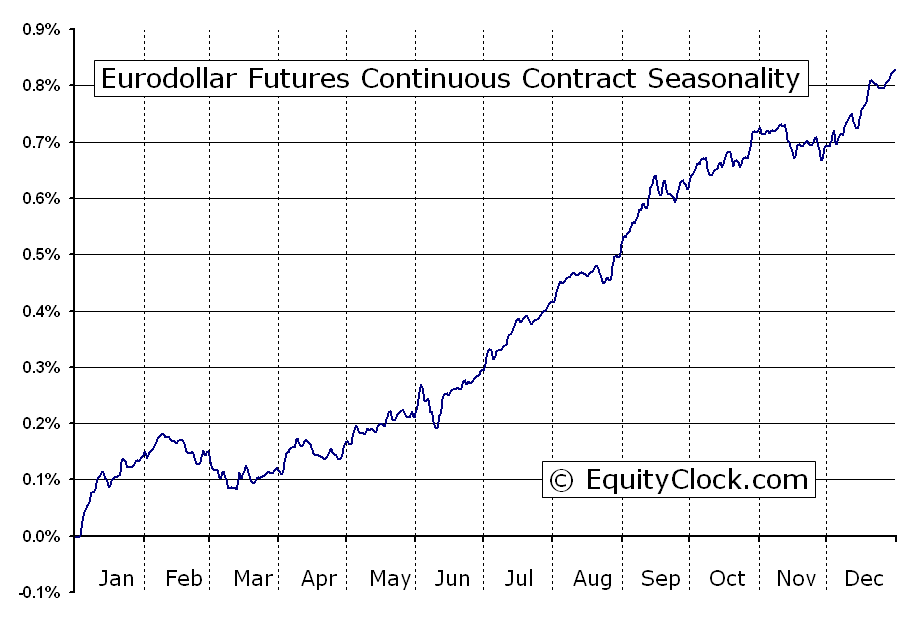Futures Eurodollar futures
Post on: 30 Май, 2015 No Comment

Eurodollar futures are a way for companies and banks to lock in an interest rate today, for money it intends to borrow or lend in the future. They are traded on the Chicago Mercantile Exchange (CME). and are the most widely traded futures in the world, with open interest (number of contracts outstanding) typically in the 7 to 9 million range for the shortest maturity futures. [1]
Eurodollar futures are a cash settled futures contract on an interest rate for a 3 month loan with a $1 million notional value. They are essentially the futures equivalent of forward rate agreements (FRAs). However, because Eurodollar futures are exchange traded, they offer greater liquidity and lower transaction costs, but can not be customized like over the counter (OTC) FRAs. Since Eurodollar futures are margined. there is virtually no credit risk because any gains or losses are marked to market. or in other words they are paid daily. As such, if interest rates move in your favor, you receive cash compensation that day rather than waiting until expiry; these settlements are done every day. Since the contract is cash settled, no loan is actually extended even though the contract mentions a notional principal amount.
Contents
Eurodollar futures terminology
Pricing of Eurodollar futures is unique in the sense that it is quoted as numerical price, despite the fact that it is an interest rate. The price quoted is simply 100 minus the implied interest rate. For instance, a price of 95.00 means an interest rate of 5.0%, while a price of 93.00 implies an interest rate of 7.0%.
- Margining refers to a method of settling gains and losses daily. The basic idea is that both the seller and the buyer of the contract puts up an initial margin account, and gains are added to this account (losses are subtracted). If the margin account falls below a certain level (called the maintenance margin ), then the CME will make a margin call. forcing the investor to either replenish money in the margin account or to close their position. Because margining is done many times throughout each trading day, this effectively eliminates credit risk from the futures contract.
- Ticks are a 0.01 change in the price (.01% change in the interest rate) of the futures contract, or the change of a single basis point (bps). In dollar terms, each tick represents a $25 gain or loss that must be paid out of a margin account. The $25 is derived as follows: $1,000,000 notional loan *(.01%)*(90/360)=$25.00. For instance, if the price were to drop from 95.00 to 94.99, then $25 is paid from the buyer’s margin account into the margin account of the seller.
Mechanics of Eurodollar Futures
Consider Company Z on March 1, 2009, which due to unforeseen circumstances must now find $10 million for an expenditure that will occur on June 1, 2009. Company Z expects to generate revenue over time, and the company expects to be able to repay this amount on September 1, 2009. Company Z has a number of ways to meet this expenditure; in this example we only compare a traditional loan to Eurodollar futures.
Let’s assume Company Z can normally borrow funds for 3 months from its local bank at a rate of 3 month Libor plus 100 basis points (bps). If the company takes the first alternative, the effective interest rate it would be able to borrow at would remain unknown until June 1, when it borrows the actual $10 million at 3 month Libor plus 100 bps. Note that this represents a variable interest rate, as the interest rate in 3 months remain unknown until the actual day arrives. What if the company wishes to know on March 1, 2009 the interest they must pay on the loan, which will not occur for another 3 months?
Company Z can also sell 10 Eurodollar future contracts (for total notional principal of $10 million) that expire on June 1, 2009. Let’s assume that on March 1, 2009 the price of Eurodollar futures is exactly 93.00, implying an interest rate of 7.0%, and that at expiry (June 1, 2009) the final closing price is 92.50, implying an interest rate of 7.5%. Since the futures price decreased 50 basis points. Company Z would have received a total of $12,500 ($25 x 50 ticks x 10 contracts) from buyers of the contract. At expiry, all accounts are margined to the final closing price and closed; there is no more activity related to this specific Eurodollar futures contract.
How do Eurodollar futures lock in interest rates?
Company Z now borrows $9,987,500 at an interest rate of 8.5%. Company Z’s overall cost of financing is < $9,987,500 * (1+ 0.085 * [ 90 / 360 ] ) / $10,000,000 > -1, which comes out to 2.0%. When annualized, Company Z’s actual cost of borrowing $10 million is 8.0%, which is exactly the Eurodollar futures price of 7.0% it agreed upon plus the 100 basis points cost of borrowing from its local bank.














